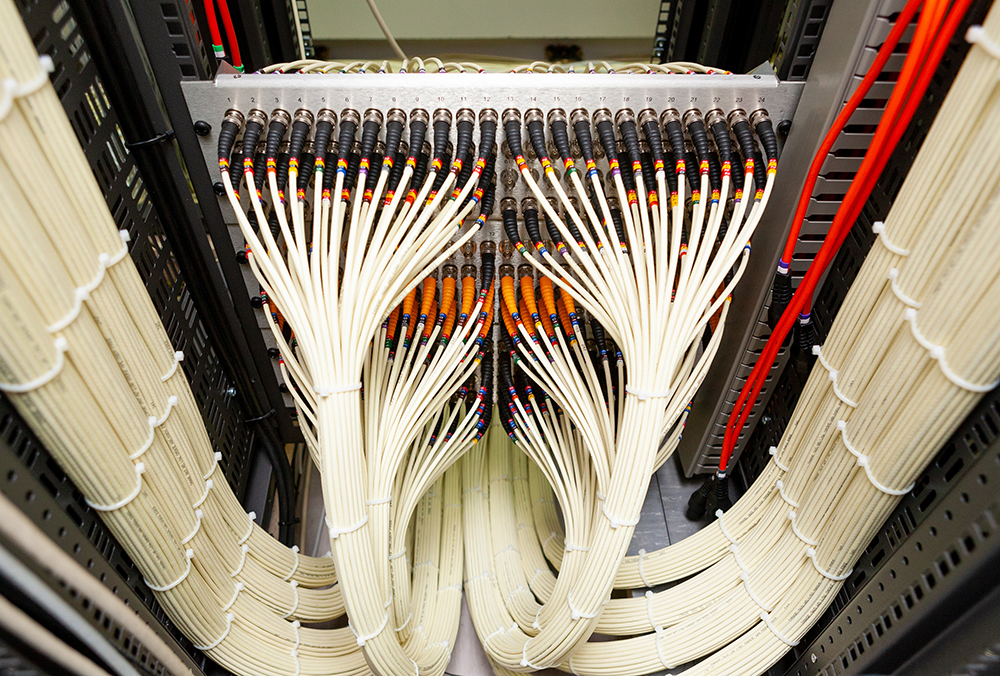Computer networking is a broad category of subjects dealing with the interconnection and communication of computers. It’s one of the most important aspects of modern life; from laptops to mobile devices to tablets, we use computer networks daily. Let’s take a closer look at what computer networking is, how it works, why computer networking is necessary, the objectives of computer networking, and much more.
What Is Computer Networking?
Let’s start by taking a step back and thinking about networking. The term “network” was first used in 1876 when Alexander Graham Bell invented the telephone network. Since then, the word has been used for many systems connecting two or more locations. So the terms “computer network and computer networking” refer to any system that connects two or more computers for information exchange.
The essential components of a computer network include:
- A physical connection between the computers.
- A protocol that allows data to be transferred between the connected computers.
- An addressing scheme that identifies each computer in the network.
- A routing table that determines how data should be sent from one computer to another.
- A communications medium that transmits data between the computers.
- A security mechanism that prevents unauthorized access to the network.
- A management tool that monitors the status of the network.
- A software application that provides an interface between users and the network.
Why Is Computer Networking Important?
The reason why computer networking is important is that it allows us to communicate with each other. Computer networks enable us to write documents, share files, and send emails to run business operations. Without computers and a stable internet connection, we wouldn’t be able to use any online services because there wouldn’t be any.
According to Gartner, worldwide IT spending is expected to reach $4.5 trillion by 2022. If your company has invested heavily in technology, it makes sense to invest in a reliable computer network infrastructure. A fast and efficient network can help reduce downtime, improve productivity, and increase employee morale. It also helps to keep up-to-date with the latest technologies.
Many companies have invested in their internal networks to stay ahead of the competition. However, suppose you want to take advantage of emerging technologies like cloud computing, virtualization, big data analytics, and other cutting-edge solutions. In that case, you need to connect your organization to external networks.
This is where computer networking comes into play. With a well-designed and maintained network, you can securely connect your company’s servers to the internet. You can even allow employees to access corporate resources over the web while protecting them from malicious attacks.
How Does Computer Networking Work?
Now that you know what computer networking is and why it’s important, let’s understand how it works. When you think about computer networking, you might imagine something like this:
Computer networks consist of two primary components: hardware and software. Hardware includes devices that perform the functions required for the network to work. These devices include routers, switches, hubs, firewalls, modems, and wireless access points. The software consists of programs that run on various devices in the network. It also includes operating systems, applications, and other software needed to make the network function.
Let’s say that you have a router sitting somewhere in your house. Your router is connected to the internet and is responsible for routing data from one place to another. Now, let’s say you’re watching TV, and you see a commercial for a new movie coming out. Instead of going directly to the website for the movie, your browser will go to the router first. The router will route the request to the correct location. Once it gets there, the router will tell the website to serve up the page for the movie. This process is called packet forwarding, just one part of computer networking. Don’t worry. We’ll take a look at more below.
Computer Networking Objectives
A computer network consists of several parts. Each part plays a specific role in helping the network function properly. When designing a computer network, you must consider these roles carefully. If you fail to design the network correctly, the result could be disastrous. For example, if you put too many computers into a network, the network might not be able to handle the load. Or if you set up the network incorrectly, the computers won’t be able to talk to each other.
There are four main objectives of computer networks:
- To provide reliable connections between computers.
- To enable computers to send messages to each other.
- To prevent unwanted messages from being received by computers.
- To keep track of where all the computers are located.
These four objectives are achieved using specific protocols, addresses, and routing tables. Let’s take a look at some supporting goals:
- To provide secure connections between computers within a local area network.
- To allow remote workers to access corporate resources.
- To provide redundancy.
- To create a private intranet.
- To offer load balancing.
- To support video conferencing.
- To facilitate disaster recovery.
- To protect against cyber threats.
- To ensure compliance with regulations.
What Are The Different Types Of Networks?
There are many types of networks, including the Campus Area Network (CAN), Metropolitan Area Network (MAN), Storage Area Network (SAN), and Passive Optical Local Area Network (POLAN). Still, we’re not going to talk about those today.
There are four major categories of computer network types: Local Area Networks, Wide Area Networks, Personal Area Networks, and Wireless Local Area Networks.
Local Area Networks
A LAN is a computer network that allows computers to exchange information within a limited geographical area. The most common LAN types include Ethernet, Token Ring, FDDI, and Fibre Channel.
Ethernet is the most widely used form of LAN technology. It is based on the IEEE 802.3 standard. This standard specifies how Ethernet works and what features it should support. Ethernet was developed in the 1970s, but it wasn’t until 1980 that it became commercially available. Today, Ethernet is found in almost every office building and home.
Wide Area Networks
WANs are larger than LANs. WANs usually cover large areas, such as cities, states, or even countries. Some WANs span the entire planet. One of the oldest and largest WANs is the internet.
The internet is a worldwide collection of interconnected computer networks that transmit data using TCP/IP protocol. It was created in 1969 by the United States Department of Defense. Since its inception, the internet has grown tremendously. At present, there are more than 4.6 billion users around the world.
The internet provides access to various services, including email, web pages, online shopping, and instant messaging. Because of this versatility, the internet is often called “the World’s Largest Communications Network.”
Personal Area Networks
PANs are smaller than LANs. A PAN connects two or more devices, such as cell phones, laptops, PDAs, digital cameras, printers, scanners, and fax machines. You can use a personal area network to connect your PDA to your computer so that you don’t have to carry both devices simultaneously.
You can also use a personal area network to connect multiple computers for file-sharing purposes. For instance, you can share files among five computers without installing software on each one.
Wireless Local Area Networks
Wirelessly connecting computers over short distances is much easier than connecting them through cables. Therefore, wireless local area networks were invented. These networks consist of small groups of computers connected via radio waves. They’re easy to build because they require no physical wiring. However, a wireless network is less secure than wired LANs.
Who Should Handle Your Business’ Computer Network?
If you own a business, you probably don’t want to handle your company’s computer network yourself. Instead, you should hire a networking professional like a managed service provider, a network administrator, or a network technician.
Managed Service Provider
A managed service provider provides computer services to businesses. MSPs typically offer a wide range of services, including computer repair, network security, operating systems, backup and recovery, virus removal, and internet connectivity. A good MSP should be able to handle many types of network architecture. They should have network engineers on staff who have experience working with network elements, networking technology, systems design, networking equipment, network management protocols, wireless systems, and node communication, and the technical skills to do so.
Network Administrator
A network administrator handles all aspects of a company’s computer network. They manage the entire network, including all network solutions, systems, networking environment, administration, installation, configuration, maintenance, and monitoring of the network 24/7. Often, a network administrator will work closely with a managed service provider. However, some companies prefer to hire their own in-house IT department.
Networking Technicians
A networking technician works directly with the physical wiring of a computer network. They install cabling, connect devices, and troubleshoot problems. Often, a network technician is also responsible for managing the network infrastructure.
What Type Of Network Should My Business Use?
When choosing a network for your business, you must consider several factors. Some of these factors include:
- Cost is probably the most critical factor when deciding which type of network to buy. Determining whether purchasing a new network is cost-effective depends on many things, including the size of your company, the number of employees, the amount of equipment needed, and the location of your business.
- Security is another significant consideration. If someone breaks into your network, he could steal confidential information, damage valuable equipment, or cause other problems. This means that it’s vital to choose a security system that meets your needs.
- Scalability is yet another critical factor when choosing a network. Your network should be able to grow as your company grows.
- Reliability is an issue if your network goes down frequently. In addition, you want a reliable network that won’t slow down during peak hours.
- Speed is an essential factor when choosing a network. You’ll want a fast network that allows you to send large amounts of data quickly.
- Ease of Installation is also a significant concern. Spending time trying to set up a new network is not fun.
- User Friendliness is another crucial factor. You want a network that makes setting up connections simple.
- Support is also an important consideration. When something goes wrong with your network, you need to know how to fix it. Making sure you don’t have an unsecured network should be a top priority. Then worry about having a cohesive network that provides a modern networking method to all connected computing devices. The best way to decide which type of networking solution is right for your company is by talking to experts who understand all aspects of network technology.
Wrapping Up

I hope this article answers why computer networking is essential in a way that is easy to understand. Just in case it wasn’t, here are some more reasons why computer networking is essential.
It makes communication easier.
A computer network enables you to send messages, share documents, and access databases from anywhere at any time. With a network, you can communicate with anyone around the world.
It helps you save money.
You can connect multiple computers using a network. This enables you to share resources such as printers, scanners, and fax machines. By sharing these items, you’re able to cut costs.
It helps keep your network secure.
Your network can help protect against hackers and viruses. Hackers use computers to find ways to break into networks to steal information, disrupt operations, or even shut them down completely. Viruses can wreak havoc on a network because they can destroy files and programs without permission. A good network keeps hackers out and protects your network from being infected.
You can make better decisions.
Using a computer network allows you to access information faster than ever. That means you can make better decisions and take advantage of opportunities that arise while you’re working.
The internet has made it possible for businesses to reach customers anywhere in the world at any time. Because of this, companies no longer depend on local suppliers. They can now source their products from manufacturers around the globe.
A good computer network can help you stay competitive
You can offer your clients and potential customers various services with a strong network. This includes online ordering, remote support, and other features that allow people to work remotely. Your business can also provide employees with training and resources that improve productivity.
In summary, there are many reasons why computer networking is essential. If you haven’t already started implementing a computer network in your organization, you may want to consider doing so soon. It’s easier to start small and grow as your needs change. You’ll find that computer networking makes your life easier and your business more successful.







Recent Comments